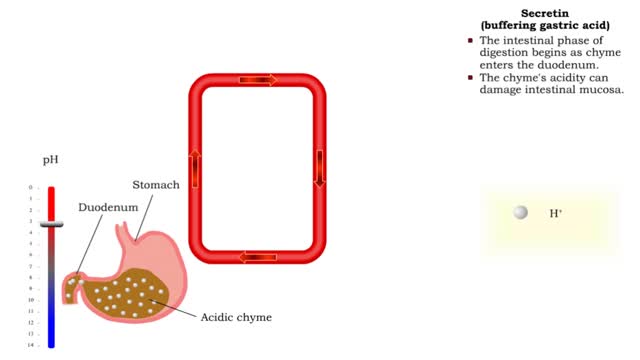Search Results
Results for: 'stomach mucosa'
By: HWC, Views: 11295
The endocrine system maintains many body conditions within normal limits with feedback loops. Each endocrine feedback loop maintains homeostasis using the following components: • Stimulus - a change in a body condition. • Production cell - an endocrine cell that produces a hormone after b...
Digestive chemicals - water, gastric acid, bile & bicarbonate
By: HWC, Views: 10906
• Water is the most abundant molecule in ingested fluids. • Water plays a primary role in hydrolytic digestive reactions. • Helps liquefy and transport digestive foodstuffs down the tract. • Transports secretions from accessory digestive organs to gastrointestinal tract. • Aids ...
Gastrin (gastric emptying) & Secretin (buffering gastric acid)
By: HWC, Views: 10709
• Gastrin also binds to the smooth muscle cells in the stomach causing: • Increased gastric motility. • Opening of pyloric sphincter. • Increased gastric emptying. • The intestinal phase of digestion begins as chyme enters the duodenum. • The chyme's acidity can damage int...
Barriers - eye structures, digestive mucosa, respiratory mucosa & genitourinary mucosa
By: HWC, Views: 11435
• Eyebrows, eyelids, eyelashes and conjunctiva serve to trap microbes preventing their invasion. • Tearing (lacrimation) is a protective mechanism that washes away microbes that attempt to enter the eyes. • Salts, mucus, and lysozymes in tears neutralize substances and bacteria. �...
Non-specific disease resistance mechanisms & Skin's defense barriers
By: HWC, Views: 11187
• Non-specific disease resistance acts quickly to fight a wide variety of invaders. • Mechanisms include: • Barriers • Antimicrobial substances • Cellular defenses • Inflammation • Fever Barriers - types • Physical and chemical bathers prevent invasion by micro...
Stomach peristalsis & Enterogastric reflex
By: HWC, Views: 10576
• Food enters, distending the stomach. • Stretch receptors activate enteric reflexes that promote peristaltic movements. • These movements, called mixing waves, begin to mix the food with stomach secretions. • Mixing waves force the digesting food (chyme) toward and through the pylo...
Stomach peristalsis - Movement of Food Through the Small Intestine
By: HWC, Views: 11188
Peristalsis is a series of wave-like muscle contractions that moves food to different processing stations in the digestive tract. The process of peristalsis begins in the esophagus when a bolus of food is swallowed. The strong wave-like motions of the smooth muscle in the esophagus carry the food...
Secretin (inhibiting gastric acid secretion), Cholecystokinin (fat digestion) & Cholecystokinin
By: HWC, Views: 11019
• As chyme approaches the small intestine, secretin also targets acid-producing parietal cells in the gastric mucosa. • Increased secretin inhibits gastric add secretion. • With less gastric acid produced, the chyme going into the intestine is less acidic. • The hormone CCK also reg...
Protein digestion - stomach & small intestine
By: HWC, Views: 10658
• Protein digestion occurs in the stomach and small intestine. • The stomach enzyme pepsin initiates the process. • Pancreatic and intestinal brush border enzymes complete the digestive process. • In the stomach, pepsin is created from pepsinogen in the presence of pH-lowering hyd...
Advertisement











